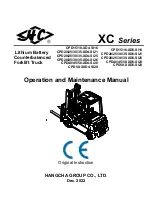
7
Hand Lever Controls
The control levers on the right control the lift, tilt and boom lift in order left to right. The
levers are pulled to get lift or to tilt the mast back and the levers are pushed for lowering or
tilting the mast forward. The frame extension is controlled by an electric switch on the dash.
THE OPERATOR MUST TURN AND LOOK AROUND THE BACK OF THE MACHINE TO
MAKE SURE NO ONE IS NEAR WHEN MOVING THE FRAME. THE STEER WHEELS
SHOULD BE IN THE STRAIGHT POSITION BEFORE TELESCOPING THE FRAME
BECAUSE TURNED STEER WHEELS WILL SHIFT THE FRONT OF THE MACHINE SIDE
TO SIDE.
Fork Removal And Installation
The carriage has two fork shafts to make it easier to remove the forks. Unbolt the carriage
shaft retainers on both sides of the carriage shaft. Pull out the shaft to release the fork. Repeat
the procedure for the other side. The installation of the forks should be performed in the
opposite order ending with the carriage shaft retainers being securely fastened. A large pinch
bar is provided to aid in the positioning of the forks. Notches have been placed above the
carriage bar to gain leverage on the fork eye.
Boom Removal and Installation
The boom attachment should be removed utilizing the boom stand provided. The horizontal
boom should be extended all the way out so it will balance on the boom stand. Remove the
retainer pin at the bottom of the boom and disconnect the hydraulics (The hydraulic quick-
disconnects have a pressure release valve built into them and should be set to the closed
position before disconnecting). Lower the boom onto the boom stand posts until the boom is
released. The installation of the boom is performed in the opposite order ending with the
installing of the retainer pin. The boom can also be lifted off the carriage using the lifting eyes
on the upper stage if the pin connecting the upper stage to the intermediate stage is in place.
Boom Vertical Extension
The boom has two hydraulic cylinders that are attached to the intermediate stage and are
controlled by the third hydraulic lever on the operator's dash. The upper boom stage can be
lifted by disconnecting the boom cylinders from the intermediate stage and raising them into
the upper stage sockets. The boom retainer pin connecting the intermediate stage to upper
stage must be relocated to the lugs that connect the stationary boom to the intermediate stage
(This is required to keep the intermediate stage from being dragged up with the upper stage).
IF A LOAD IS BEING LIFTED WITH THE UPPER STAGE, THE PINS MUST BE INSTALLED
ON THE ROD END OF THE CYLINDERS. DO NOT USE THE CYLINDER SOCKETS ON
THE UPPER BOOM TO LIFT A LOAD. THE UPPER BOOM SOCKETS ARE ONLY TO BE
USED WHEN LIFTING THE UPPER BOOM SECTION WITHOUT A LOAD. A rectangular
pin is supplied in the storage compartment that wil fit into a hole in the upper stage to retain
it. The boom cylinders can then be lowered and pinned to the intermediate stage for achieving
greater height.


















